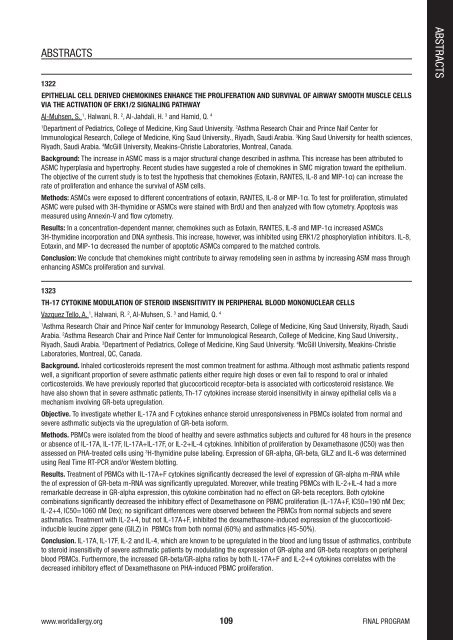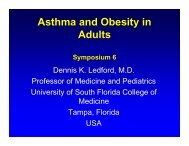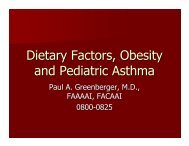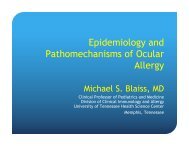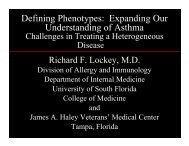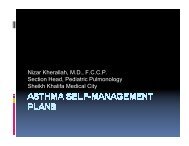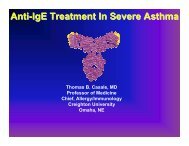Dubai Final-v20.indd - World Allergy Organization
Dubai Final-v20.indd - World Allergy Organization
Dubai Final-v20.indd - World Allergy Organization
Create successful ePaper yourself
Turn your PDF publications into a flip-book with our unique Google optimized e-Paper software.
ABstrACts<br />
1322<br />
EPiTHElial CEll DEriVED CHEmoKinES EnHanCE THE ProliFEraTion anD SUrViVal oF airWaY SmooTH mUSClE CEllS<br />
Via THE aCTiVaTion oF ErK1/2 Signaling PaTHWaY<br />
Al-muhsen, s. 1 , Halwani, r. 2 , Al-Jahdali, H. 3 and Hamid, Q. 4<br />
1 2 Department of Pediatrics, College of medicine, King saud University. Asthma research Chair and Prince naif Center for<br />
immunological research, College of medicine, King saud University., riyadh, saudi Arabia. 3King saud University for health sciences,<br />
riyadh, saudi Arabia. 4mcgill University, meakins-Christie laboratories, montreal, Canada.<br />
Background: the increase in AsmC mass is a major structural change described in asthma. this increase has been attributed to<br />
AsmC hyperplasia and hypertrophy. recent studies have suggested a role of chemokines in smC migration toward the epithelium.<br />
the objective of the current study is to test the hypothesis that chemokines (Eotaxin, rAntEs, il-8 and miP-1α) can increase the<br />
rate of proliferation and enhance the survival of Asm cells.<br />
methods: AsmCs were exposed to different concentrations of eotaxin, rAntEs, il-8 or miP-1α. to test for proliferation, stimulated<br />
AsmC were pulsed with 3H-thymidine or AsmCs were stained with BrdU and then analyzed with flow cytometry. Apoptosis was<br />
measured using Annexin-V and flow cytometry.<br />
results: in a concentration-dependent manner, chemokines such as Eotaxin, rAntEs, il-8 and miP-1α increased AsmCs<br />
3H-thymidine incorporation and DnA synthesis. this increase, however, was inhibited using ErK1/2 phosphorylation inhibitors. il-8,<br />
Eotaxin, and miP-1α decreased the number of apoptotic AsmCs compared to the matched controls.<br />
Conclusion: We conclude that chemokines might contribute to airway remodeling seen in asthma by increasing Asm mass through<br />
enhancing AsmCs proliferation and survival.<br />
1323<br />
TH-17 CYToKinE moDUlaTion oF STEroiD inSEnSiTiViTY in PEriPHEral BlooD mononUClEar CEllS<br />
Vazquez tello, A. 1 , Halwani, r. 2 , Al-muhsen, s. 3 and Hamid, Q. 4<br />
1Asthma research Chair and Prince naif center for immunology research, College of medicine, King saud University, riyadh, saudi<br />
Arabia. 2Asthma research Chair and Prince naif Center for immunological research, College of medicine, King saud University.,<br />
riyadh, saudi Arabia. 3Department of Pediatrics, College of medicine, King saud University. 4mcgill University, meakins-Christie<br />
laboratories, montreal, QC, Canada.<br />
Background. inhaled corticosteroids represent the most common treatment for asthma. Although most asthmatic patients respond<br />
well, a significant proportion of severe asthmatic patients either require high doses or even fail to respond to oral or inhaled<br />
corticosteroids. We have previously reported that glucocorticoid receptor-beta is associated with corticosteroid resistance. We<br />
have also shown that in severe asthmatic patients, th-17 cytokines increase steroid insensitivity in airway epithelial cells via a<br />
mechanism involving gr-beta upregulation.<br />
objective. to investigate whether il-17A and F cytokines enhance steroid unresponsiveness in PBmCs isolated from normal and<br />
severe asthmatic subjects via the upregulation of gr-beta isoform.<br />
methods. PBmCs were isolated from the blood of healthy and severe asthmatics subjects and cultured for 48 hours in the presence<br />
or absence of il-17A, il-17F, il-17A+il-17F, or il-2+il-4 cytokines. inhibition of proliferation by Dexamethasone (iC50) was then<br />
assessed on PHA-treated cells using 3H-thymidine pulse labeling. Expression of gr-alpha, gr-beta, gilZ and il-6 was determined<br />
using real time rt-PCr and/or Western blotting.<br />
results. treatment of PBmCs with il-17A+F cytokines significantly decreased the level of expression of gr-alpha m-rnA while<br />
the of expression of gr-beta m-rnA was significantly upregulated. moreover, while treating PBmCs with il-2+il-4 had a more<br />
remarkable decrease in gr-alpha expression, this cytokine combination had no effect on gr-beta receptors. Both cytokine<br />
combinations significantly decreased the inhibitory effect of Dexamethasone on PBmC proliferation (il-17A+F, iC50=190 nm Dex;<br />
il-2+4, iC50=1060 nm Dex); no significant differences were observed between the PBmCs from normal subjects and severe<br />
asthmatics. treatment with il-2+4, but not il-17A+F, inhibited the dexamethasone-induced expression of the glucocorticoidinducible<br />
leucine zipper gene (gilZ) in PBmCs from both normal (60%) and asthmatics (45-50%).<br />
Conclusion. il-17A, il-17F, il-2 and il-4, which are known to be upregulated in the blood and lung tissue of asthmatics, contribute<br />
to steroid insensitivity of severe asthmatic patients by modulating the expression of gr-alpha and gr-beta receptors on peripheral<br />
blood PBmCs. Furthermore, the increased gr-beta/gr-alpha ratios by both il-17A+F and il-2+4 cytokines correlates with the<br />
decreased inhibitory effect of Dexamethasone on PHA-induced PBmC proliferation.<br />
www.worldallergy.org 109<br />
FinAl PrOgrAm<br />
ABstrACts


